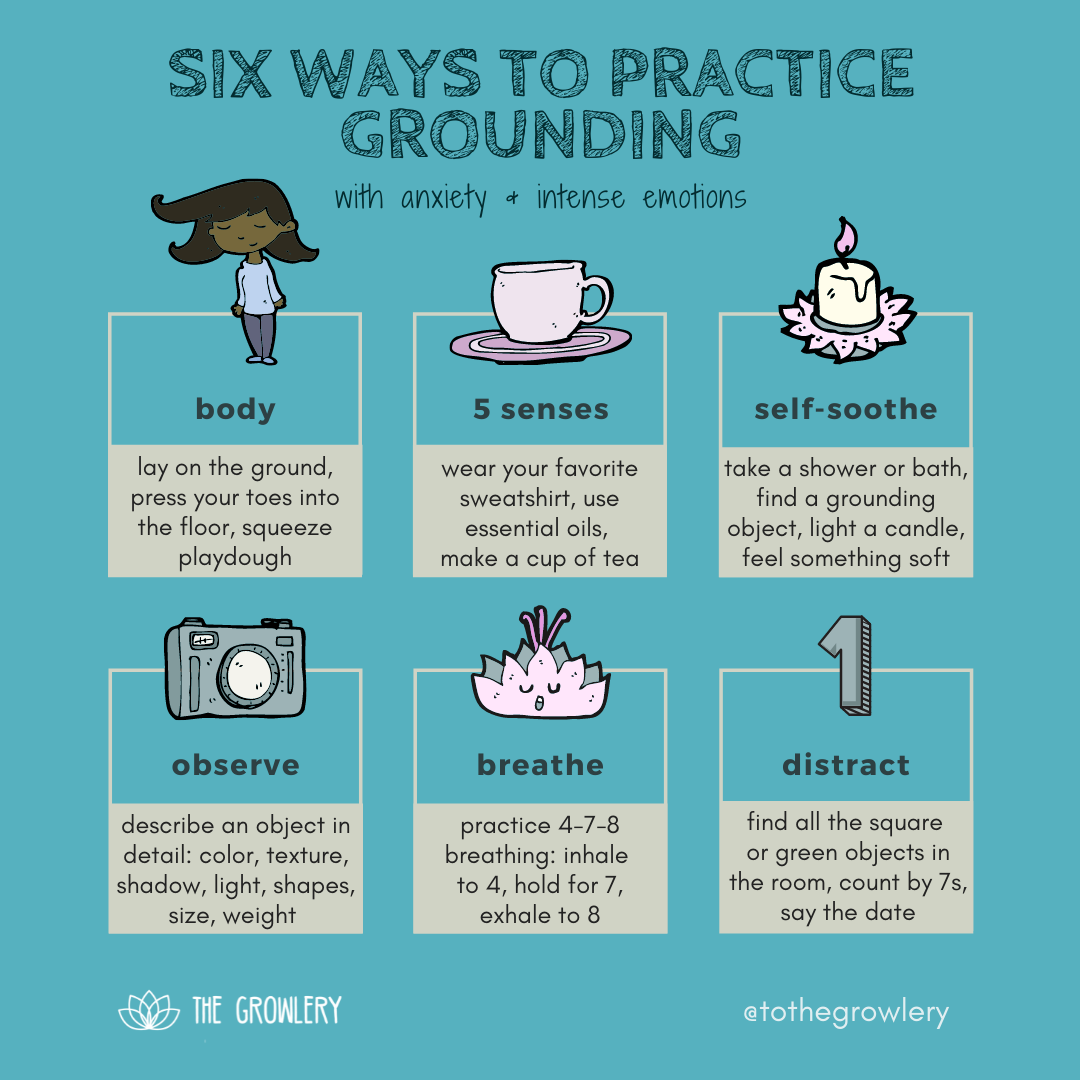Six Different Types of Grounding Exercises for Anxiety and Intense Emotions
When we're in the middle of an anxiety attack or flashback, our frontal lobe goes out the window. It feels impossible to focus or think clearly about anything and sometimes our thoughts come so quickly and jumbled we can't keep track of them. Things may seem like they are happening around us in a blur, or someone has been talking for several minutes and we have no clue what they just said. Sometimes we feel paralyzed or frozen, unable to move or say or do anything. This can happen with other intense or extreme emotions, too, like when we feel hurt or abandoned, hopeless, frightened, or lost.
Grounding is an excellent tool for these kinds of situations, and is one that can be used just about anywhere. By bringing our mind and our body back to the present moment, we can sometimes allow ourselves the space for our brain to slow down and feel a bit more centered, at least enough so we can let someone know what's going on or that we need help, or figure out what to do next. There are many different ways of grounding, which is part of why it's such a great skill -- even if you don't find one of the options below helpful there are many others you can try. You can also create your own ways of grounding, by finding anything to focus your senses on and anchor you in the present moment.
Here are some of my favorite grounding techniques, sorted by some different categories/types:
SELF-SOOTHING:
Take a shower or bath. Focus on each step of preparing the bath or shower, noticing every small detail--what does your hand feel like as it touches the doorknob, the faucet? Where do you turn the faucet to, how do you get the right temperature? Notice the sensation of the water on your body, paying attention to the warmth, the sounds, how your muscles feel.
Find a grounding object to keep with you. It can be something soft like a smooth stone or polished marble, or a piece of fabric or yarn whose texture you find comforting; it can even be a small figuring or something that brings positive memories. Keep the object with you somewhere where it can be easily located and pull it out when you need to practice grounding. Pay attention to and describe in your mind each detail of the object, touching it with your hand and noticing any sensations that come with it.
Make a cup of tea, coffee, or hot chocolate. Complete each step with precision, noticing every movement your body makes; your fingers grasping the handle of the kettle, the coldness of the faucet as you turn on the water, how the kettle gets heavier as you fill it. When you are done, mindfully sip the beverage while seated somewhere calming or relaxing.
NOTICE WITH YOUR 5 SENSES:
Find a familiar scent (perfume, soap, lotion, tea, essential oil, etc.) and make a routine of smelling it in the morning, before bed, or another routine part of your day. Have the scent with you and smell it when you are in need of grounding, combining this with some slow, deep belly breaths.
Put on your favorite item of clothing--maybe a pair of socks, a favorite sweater, a soft t-shirt. Notice the texture, the color, the way it smells. You can also find a favorite blanket or pillow and do the same.
Wrap yourself tightly in a blanket. Squeeze yourself in a big bear hug or ask someone else to do this for you. Rub your arms and legs, moving up from your feet to your thighs, and down from your shoulders to your wrists.
USE YOUR BODY:
Notice your feet on the floor. You can even stand up and plant your feet firmly, taking off your shoes and pressing each toe into the ground or floor, feeling the sensation of being connected to the floor, the foundation of the building, the dirt underneath it, and the earth's gravity. You can also do this while sitting in a chair or laying down.
[My personal favorite] Literally ground yourself. Lay on the floor. Do a quick body scan and notice each part of your body where the floor touches you, and focus on that sensation, the pressure, the texture, the temperature. Notice any vibrations in the house or building. You can also listen to music with the speaker on the floor, and feel the vibrations of the sounds.
MOVE! Wiggle your toes, paying attention to the sensation as you move each one. See which toes you can move independently of the others. Do the same with your fingers, feeling the stretch in your muscles, the tension and relaxation as you move.
Rhythm. Tap your feet on the floor, find an object to make a soft sound, tap your fingers on the table or lightly tap a glass or other surface until you find a pleasant sound, then create a rhythm and repeat it, staying focused on the beginning and end of each sound you create.
Do an activity that requires engaging your hands or whole body. Go out into your garden and pull weeds. Work on a knitting project. Play with kinetic sand, silly putty, or another fidget. Wash the dishes, paying attention to the sensations. Fold your laundry.
OBSERVE YOUR SURROUNDINGS:
Go outside (or find a window you can look out) and pick an object. Notice as many details about the object as you can. For example, if you choose a tree, notice where the light falls on its branches and where the shadows lie. Notice how many limbs it has, and whether there are any buds or leaves on the tree. Notice the texture of its bark, whether the limbs are straight or curved, the shape and design of its leaves.
Walk slowly through the space you are in, and practice noticing each step as your feet touch the ground. Notice which part of your foot touches the ground first, and where you notice the pressure. Notice your feet leaving the ground, and the moment where you are balancing on one foot as you take the next step.
Find something in your environment that has a repeating pattern and try to replicate it by drawing it on paper. For example, you might try to draw the pattern of the ceiling tiles, or carpet, or wood grain of a table.
Describe the room you are in to yourself, either out loud or in your mind. If the room is very cluttered or large, you can choose a small area of the room, or a specific object like a bookshelf--notice the angle of the objects, the colors, the light and shadows, the textures and shapes.
If you're in a public place, look at the people around you and try to notice details about their appearance. What color shoes are people wearing? How many of them have on jackets? Is anyone carrying an umbrella or briefcase? What are people's hairstyles like?
DISTRACT YOUR BRAIN:
Count by 7s, as high as you can (or any other interval).
Play the 'guess their occupation' game. Look at people around you and try to guess their jobs or occupations, or where they are going.
Look up today's date. Repeat to yourself the day of the week, month, year, time of day, and where you are currently. Remind yourself that you are in this moment, not in the past, and right now you are safe. Notice the season it is outside, what the sky looks like. Name the street you are on and the zip code.
Play the categories game with yourself--choose a category like colors, animals, foods, and try to name at least 10 things in that category. You can also use the alphabet and try to name something in that category for each letter of the alphabet, beginning with A,B,C, and so on.
Choose a shape (triangle, oval, square) and try to find all of the objects around you of that shape. You can also do this with colors--e.g. find all of the green things in the room.
BREATHE
Do belly breathing--place one hand on your stomach, and the other on your chest. Breathe slowly and deeply into your belly, trying to raise your hand like you are filling up a balloon or beach ball with air. Try to keep the hand on your chest still, breathing only into your stomach. Slowly breathe out, feeling the hand on your stomach lower like the balloon or ball is deflating.
4-7-8 breathing: Breathe in slowly, counting to 4 seconds while you inhale. Then, hold your breath for 7 seconds. Finally, breathe out slowly and softly, counting 8 seconds while you exhale. Repeat as many times as feels comfortable. (Note: Everyone has different body sizes and lung capacities, so if this particular combo feels uncomfortable you can adjust the numbers to whatever feels good to you. The point is just having a pattern to follow and slowing your breath.)
Note that grounding is not about making the emotion go away or detaching from your experience; it is about tolerating the experience and emotions while staying present in your body. It is important to discuss these experiences with a therapist or qualified mental health professional, especially if you are noticing frequent panic attacks, flashbacks, or dissociation.




